Quote of the day: “Happiness. Simple as a glass of chocolate or tortuous as the heart. Bitter. Sweet. Alive.”
― Joanne Harris, Chocolat
I was curious about how chocolate is made from the cacao bean. When I heard about a class that Tom Sharkey (Owner of Shark’s Coffee in Hilo and Honamu) offered, I signed up.
Most of us know that chocolate comes from the Cacao fruit. But most of us don’t have a clue how it becomes chocolate.
Cacao is not native to Hawaii, but more and more farmers here are trying their hand at growing it. The interest in dark chocolate and gourmet chocolate is creating an economic impetus for Hawaiian cacao growing and processing.
Cacao grows quite well at altitudes less than 1200 feet on the rainy side of the island (I’m not sure how it would do on the dryer Kona side of the island) and with the current interest in the beneficial effects of chocolate, there is a growing (get it?) presence of cacao trees on the Big Island.
Tom Sharkey is one of the reasons that cacao is catching on. Owner of Shark’s Coffee in Hilo and Honamu, Sharkey grows both cacao and coffee on his own land and buys cacao and coffee beans from other local growers to use in his coffee shops and to make chocolate (which he sells in his coffee shops and at the Hilo Farmer’s Market). He also teaches anyone who wants to know what they need to know to get started growing cacao, starts his own seeds and sells young cacao trees, and is working to get state help in creating the types of appropriate technology to support more production of Hawaiian chocolate.
Cacao trees take 2-3 years to mature to where they will flower and bear fruit. And once a tree is mature it can produce fruit year-round. A good-sized tree can produce 50 or more fruits per year. It takes five months from flower to fruit harvest. While they fruit year-round, the biggest harvest months are October – April. It takes 5 months from blossom to mature fruit and trees tend not to bloom a lot or set a lot of fruit during the winter months.
Each cacao pod weighs roughly a pound (some varieties produce larger pods, some smaller). The going rate for cacao pods is 30 cents per pound whole or $1.85 per pound for freshly harvested beans.
In the chocolate making class, we headed out to the cacao plantation (an acre of cacao trees Sharkey planted about 16 years ago. He showed us how to tell which pods were ripe and how to cut the pods from the tree preserving the bud from which it was likely another flower blossom and fruit would come.
Once the cacao pods are harvested, they need to be cracked open and the wet beans are shucked into pails. Cracking and shucking the beans is fun, at least when you have a whole group of enthusiastic learners trying their hand at it. There were about 12 people in our class and before we had left Sharkey’s place that day, we had shucked about a pickup load (or more) of pods. The large metal draining tank was filled to over-flowing and still there were more beans.
The fruit that surrounds each cacao bean is sweet, fruity tasting, and juicy. The beans are placed in a large metal tank with small holes for liquid to escape in the bottom. Sharkey places a 5 gallon water bottle under an opening in the bottom of the metal tank. And as the weight of pound after pound of freshly shucked beans exerts its force, cacao juice drains down into the large bottle. Even as the juice is draining into the large bottle, it is surrounded by ice to keep the juice from starting to ferment. Even refrigerated, the juice will ferment in 3-5 days. His wife sells the juice for $7.00 per quart. She says it is best over crushed ice as the juice is a little thick and crushed ice would both cool and thin it perfectly.
Each of us in the class got to taste the cacao juice and some slightly fermented cacao juice. Mmmmmm…. it was thick and sweet and very tasty.
Once the beans are shucked, they are left to drain for 1-2 days. Then they are placed in buckets (with fermentation “starter” made from a few beans that have been fermenting in a small bucket for a week or more). The fermentation process relies on yeast from the air. And by creating a “starter” that he uses to seed the fermentation process, Sharkey speeds up the process. It is more of an art than a science. He has learned by trial and error how hot to let the beans get and how long they need to ferment. Each batch is different as the weather and the starter and beans are different.
Fermenting the beans removes the fruit covering of the beans and also has some impact on flavor (I think). We didn’t get to see that part of the process as it takes several days.
Once the beans are fermented and rinsed, they are placed on metal screens where they get lots of filtered sun (covered to prevent rain from making them mold). If the weather cooperates, the beans dry and are ready to roast. If it is too wet and humid for too long, the beans mold and mildew and have to be thrown away.
After the beans are dried, they are picked through to remove any deformed and shriveled beans (you only want to roast the best beans).
Tom’s equipment for most of the process is created through ingenuity, elbow-grease, and duct-tape.
He uses a small coffee-roasting oven to roast the cacao beans and has learned by trial and error to only fill the roasting basket half full to get the best roasted bean flavor.
The beans are roasted for two cycles of 20 minutes. Once they are roasted, they’re ready to grind. Sharkey uses an electric drill rigged to some sort of metal funnel to grind the beans. The the shells are separated from the cacao nibs by shaking the ground beans through a plastic sifting basket and then running them through another hand-rigged machine that blows air (from a vacuum cleaner across the cracked beans. The heavy nibs fall through a tube to a container below while the shell blows out the back of the machine. The cracked beans are run through this machine 12 times (yes, 12!) to get as much of the debris separated from the nibs as possible. Then they pick through the nibs to remove any remaining remnants of shell.
The shells that were sifted out earlier are run through the drill “grinder” again to remove even more nibs and then go through the machine that blows air 12 times as well.
Now comes the fun part! You can eat the roasted nibs or use them to make chocolate.
To make chocolate, Sharkey uses a peanut butter grinder to grind the nibs into a somewhat dry paste. Then he has some sort of machine that constantly turns two wheels in a large bowl which slowly liquifies the chocolate by raising the temperature through the friction of the wheels turning.
Starting with 5 pounds of nibs that have been run through the peanut butter maker, he tosses in a handful of ground nibs and a bit of sugar (needing 1.85 pounds of sugar per 5 pounds of nibs to get 73% cacao content). The nibs and the sugar need to be added very gradually so the process can take a day or more. We got to see the tail end of a batch and then help Sharkey start a new batch of chocolate.
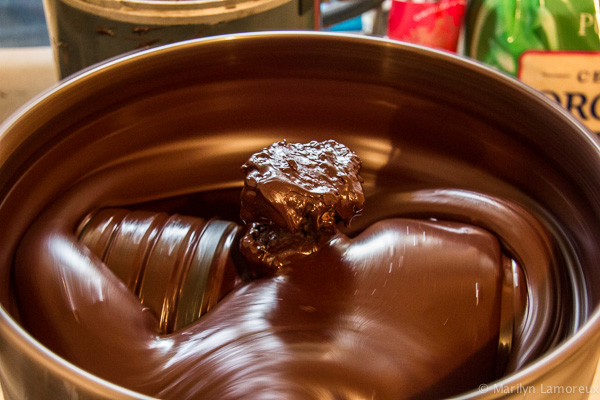
This is what 5 pounds of cacao nibs, 1.85 pounds of sugar, and a teaspoon of vanilla look like after processing
Sharkey also grows his own vanilla beans, cures them and uses them to make his own vanilla (5-6 pods in a bottle of vodka for a year makes a pretty nice vanilla). Each batch of 5 pounds of cacao nibs takes only a capful (1 to 1 1/2 teaspoon) of vanilla.
The slow turning of the wheels int he bowl gradually liquify the chocolate, getting up to 120 – 130 degrees. A small bowl of chocolate is removed from the large bowl with the turning wheels and allowed to cool to 90 degrees. It is then added back in to “seed” the chocolate. (I’m not absolutely certain about this part of the process as he went over it pretty quickly.) Once the entire batch reaches the right temperature, the chocolate is placed into large ketchup bottles and quickly poured and squeezed into the chocolate molds. The molds are popped into the refrigerator for 20-30 minutes and voila, amazing dark chocolate.
The plastic bottles used to pour the chocolate are placed in the refrigerator to harden any remaining chocolate. It is then squeezed to break it up and added to the current batch of chocolate. No chocolate is wasted in this process!
No wonder the good stuff is so expensive. It takes a lot of work and a lot of time to create one chocolate bar of Sharkey’s chocolate.
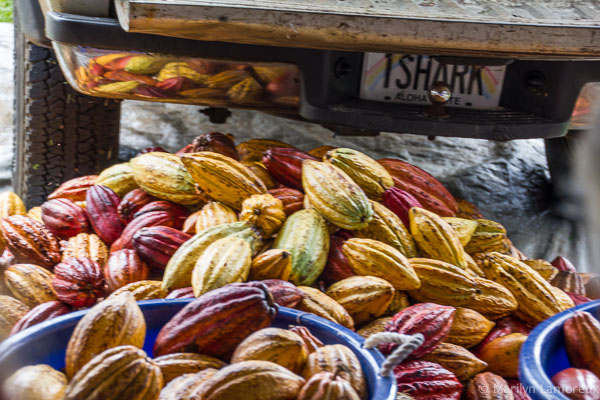
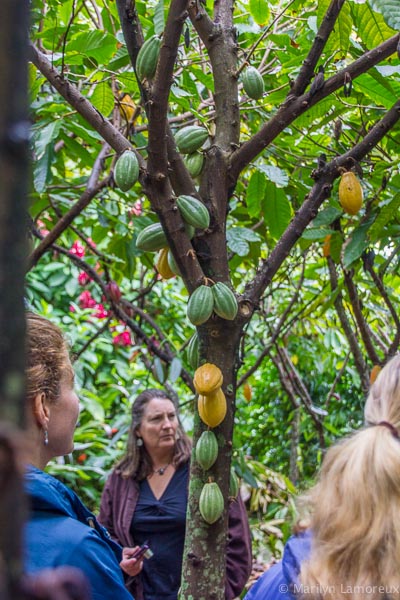
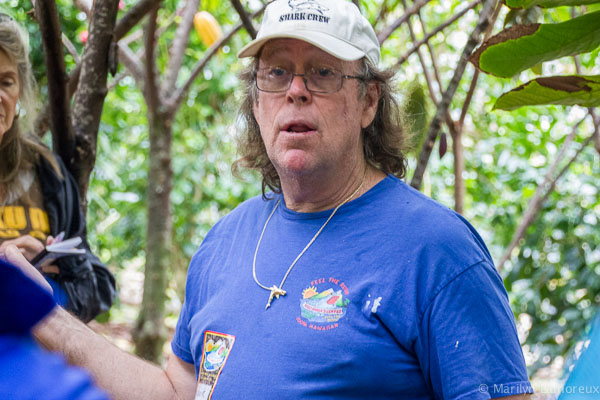
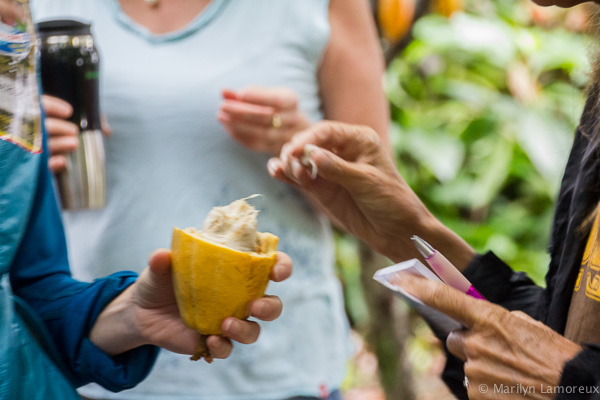

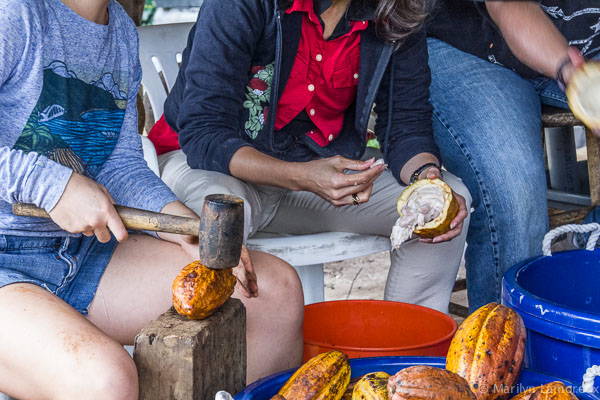




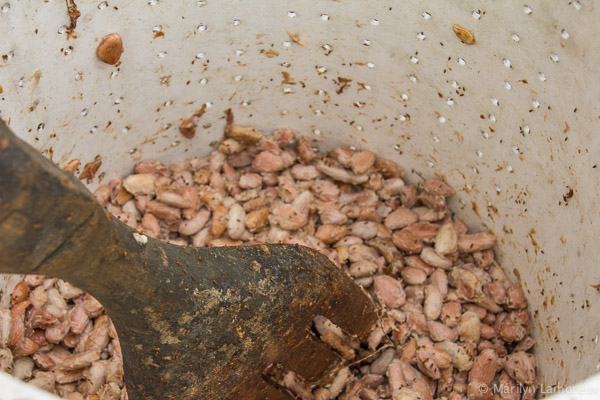
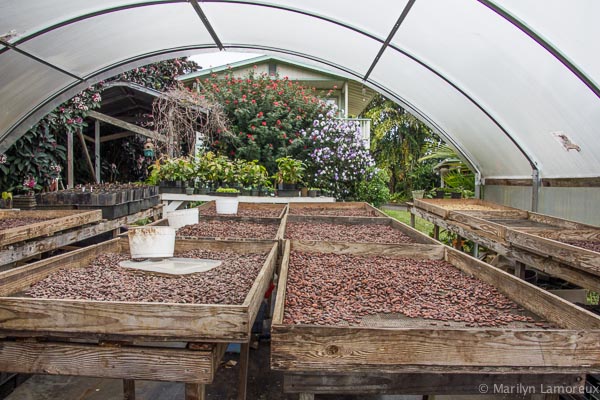

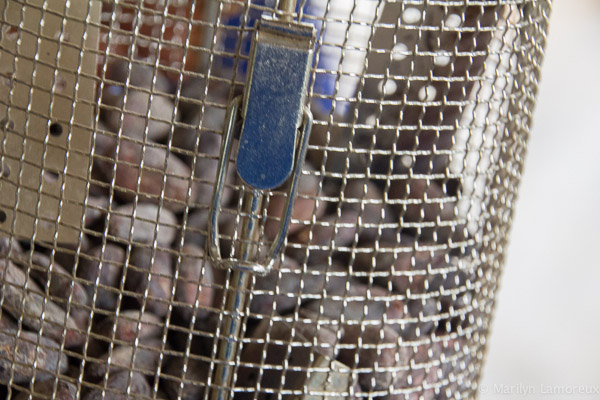
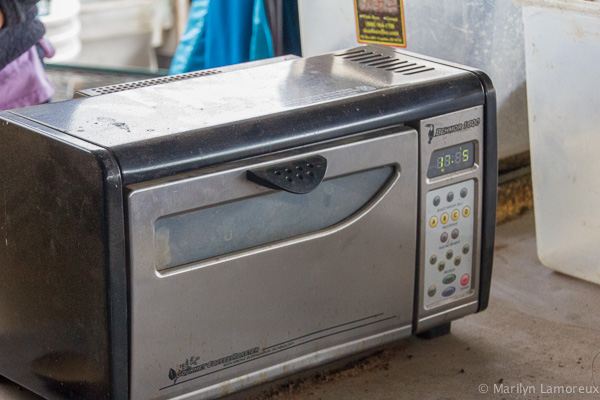



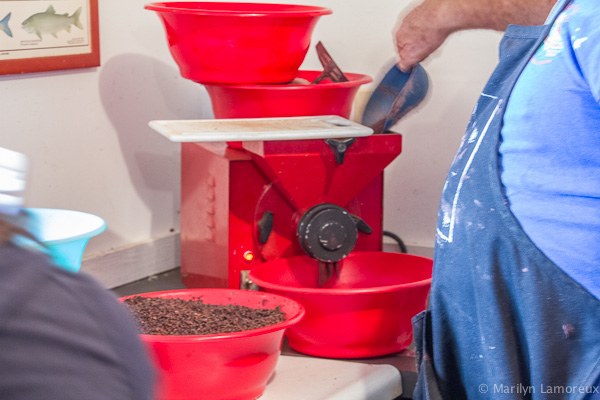
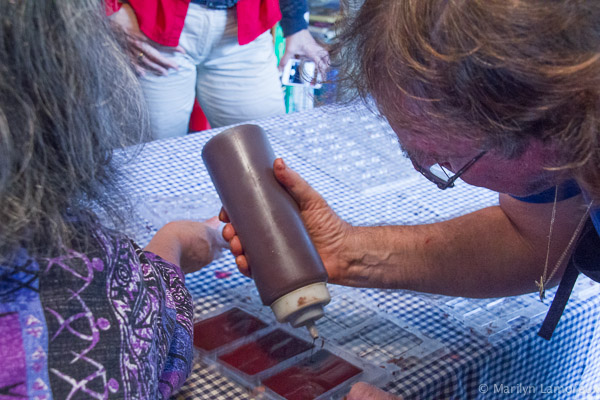
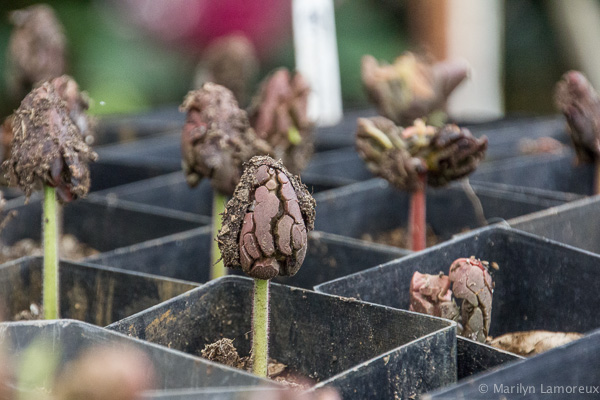
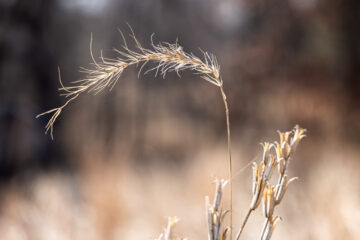


0 Comments